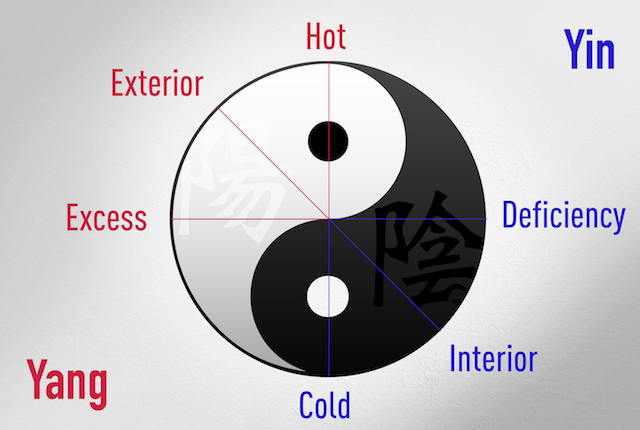The 8 Principles of TCM: Going Beyond Yin & Yang to Assess Imbalances

The 8 Principles of TCM are used to assess and correct imbalances in health in traditional Chinese Medicine.
The 8 Principles of TCM assesses symptoms, and ultimately helps bring the patient back to balance. By contrast, in western medicine, the medical field uses ICD codes to diagnose conditions. The International Classification of Diseases (ICD) contains nearly 70,000 diagnostic codes.
Yin and Yang energies are two of the eight principles in assessing imbalances. Much like Yin and Yang, the other six principles are symbiotic opposites.
To illustrate, let’s use a common example of an imbalance and how some of the 8 principles differs from western medicine in treating the imbalance. Then, we’ll examine the 8 principles in more detail.
Interior and Exterior
The common cold is a virus. Western medicine treats colds with over-the-counter remedies. Many of these popular brand name remedies contain dextromethorphan. Dextromethorphan suppresses the urge to cough. But coughing is the body’s natural way to purge toxins and phlegm from the body.
TCM diagnoses cold symptoms differently. One matching pair of the 8 principles is Interior/Exterior. In the case of the common cold, in TCM, the virus occurs because of an exterior influence. The pathogen (cold virus) has invaded the body. But if a chest cold develops where it is painful to cough, or if there is phlegm, this would be an interior condition (specifically, in the Lungs.)
Interior/Exterior pinpoints the location of the imbalance.
Cold and Heat
The next pair of principles is cold and heat. This pair and all others work in harmony with each other. For example, an external pathogen can have hot or cold properties. Fever, hot flashes and other conditions such as constipation are characteristic of heat. These heat related conditions are caused by an excess of Yang energy.
Examples of Cold symptoms are diarrhea and abdominal pain, vomiting, chills and paleness.
Full and Empty
Also called ‘Xu’ (deficiency) and ‘Shi’ (excess), the concepts of full and empty are the next pair of the 8 Principles of TCM. Again, all four pairs of diagnostic principles are interconnected. Using the common cold example, we can say that Qi energy in certain channels or Organs are Xu. Having acute intolerable pain would be an example of Shi.
This is a very simple example of Full and Empty. TCM practitioners, of course, have a thorough understanding of meridians and organ systems. Certain conditions can simultaneously present both Full and Empty characteristics.
Yin and Yang
The final pair of the four pairs of the 8 Principles is Yin and Yang. Three of the principles contain Yin characteristics and three others have Yang qualities. The 3 Yang Principles are: Exterior, Excess, and Heat. The 3 Yin Principle qualities are: Cold, Deficiency and Interior.
Yin and Yang not only apply to symptom characteristics, they also apply to human traits. For the TCM practitioner, it’s important to fully understand the constitution of the patient. For example, if somebody is what in the west would be referred to as “Type A” this is a Yang quality. The practitioner, then, would want to help restore the patient back to balance with a Yin tonic.
And for someone who has excess Yin, they may appear pale and lethargic. In light of this, the TCM practitioner, then, would want to provide the patient with a Yang tonic.
The 8 Principles of TCM: Conclusion
In summary, this is a rather simplistic explanation of the 8 Principles. It’s merely intended to serve as a basic introduction for the lay person new to traditional Chinese medicine. The important takeaway from this blog post is that TCM seeks to bring people who are experiencing imbalances back to balance in a natural way. Imbalances in TCM are not treated by only treating symptoms, but by using these 8 Principles to determine the root cause of the imbalance.





